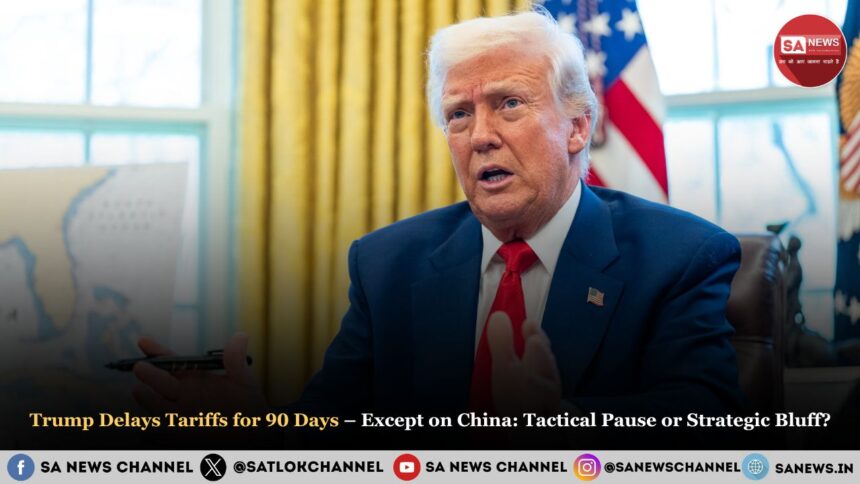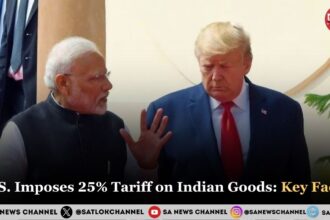President Donald Trump has announced a 90-day pause on the implementation of new tariffs for most nations, excluding China. This move aims to stabilize markets, address business and political concerns, and create a window for the U.S. to negotiate more favorable trade terms. Additionally, the administration has exempted certain electronics, including smartphones and computers, from the steep 125% tariffs previously imposed on Chinese imports, as well as a 10% global tariff. This decision, effective retroactively from April 5, 2025, follows pressure from the technology sector, which warned that the tariffs could significantly raise costs for U.S. consumers.
President Trump announces a 90-day tariff pause Key Points:
- Tariff delay announced by Donald Trump for 90 days on new implementations.
- The delay applies to almost all countries, except China.
- This pause creates a window for the U.S. to renegotiate trade deals and explore strategic opportunities.
- China retaliated with an 84% import duty in response to U.S. tariffs.
- The U.S. then raised tariffs on Chinese goods to a total of 125%.
- Exemptions granted to electronics such as smartphones, laptops, and semiconductors from these tariffs.
President Trump announces a 90-day tariff pause Current Situation
The U.S. has temporarily paused the reciprocal tariff plan for 90 days, maintaining a baseline tariff of 10% for most countries. However, tariffs on selected Chinese goods have been escalated to 125%. Additionally, certain electronics, including smartphones, laptops, and semiconductors, have been exempted from these tariffs, effective retroactively from April 5, 2025.
Why Is Trump Targeting China?
Although other countries have received temporary relief through a standard 10% tariff during the 90-day pause, China is being singled out. This is because China retaliated to the U.S.’s reciprocal tariff plan with an aggressive 84% import duty on U.S. goods. In response, Trump declared:
“Based on the lack of respect that China has shown to the world’s markets, I am hereby raising the tariff charged to China by the United States of America to 125%, effective immediately,” he posted on social media.
This aggressive move is strategic and appears aimed at isolating China economically to increase pressure.
Tactical Pause or Strategic Bluff?
Whether this is a tactical pause or a strategic bluff, the U.S. seems to benefit either way. If it’s a tactical move, it opens the door for negotiation with key allies like the EU, Japan, and India, signaling that the U.S. is reasonable and open to dialogue.
Also Read: US President Donald Trump Says India Will Lower Tariffs Significantly
If it’s a strategic bluff, it seems designed to isolate and pressure China while encouraging other nations to reconsider their trade dependencies and reduce reliance on Chinese imports.
What’s Next After the 90-Day Pause?
Many countries have welcomed the 90-day pause and are using this time to negotiate fairer deals with the U.S. However, it remains uncertain whether this will lead to long-term peace or trigger more trade conflicts. For now, global markets have stabilized temporarily, but the future remains uncertain especially with China still in the spotlight.
What Can Bring Both Financial Stability and Mental Peace?
One thing that can bring both financial stability and inner peace is the spiritual wisdom of God Kabir and the teachings of Sant Rampal Ji Maharaj. Walking on the divine path leads to righteous living, which not only strengthens financial discipline but also grants peace of mind, reduces stress, and equips one to handle life’s challenges with clarity and strength.
FAQs about President Trump announces a 90-day tariff pause
What is a tariff?
A tariff is a tax imposed by a government on goods and services imported into the country.
What is the biggest issue with increased tariffs?
Higher tariffs can negatively impact the market by reducing consumption due to increased prices.
Who are China’s largest trading partners?
China’s top trading partners include the United States, Japan, and several European countries.
Which sectors are most affected by tariffs?
The architecture, automotive, agriculture, and manufacturing sectors are among those most impacted by high tariffs.
Has the U.S. used similar pauses or tariffs in the past?
Yes, the U.S. has a history of using tariffs and temporary pauses as part of broader trade negotiations.









